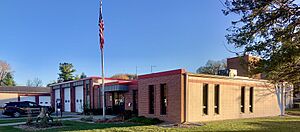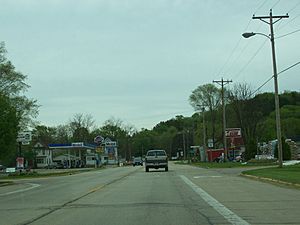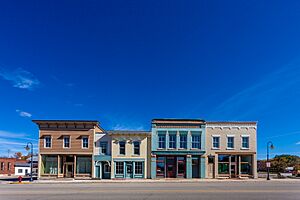Mazomanie, Wisconsin facts for kids
Quick facts for kids
Mazomanie, Wisconsin
|
|
|---|---|
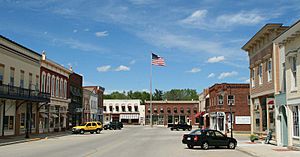 |
|
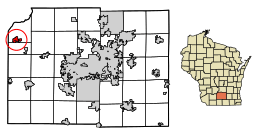
Location of Mazomanie in Dane County, Wisconsin.
|
|
| Country | |
| State | |
| County | Dane |
| Area | |
| • Total | 1.78 sq mi (4.61 km2) |
| • Land | 1.76 sq mi (4.55 km2) |
| • Water | 0.02 sq mi (0.06 km2) |
| Elevation | 745 ft (227 m) |
| Population
(2020)
|
|
| • Total | 1,768 |
| • Density | 993.3/sq mi (383.5/km2) |
| Time zone | UTC-6 (Central (CST)) |
| • Summer (DST) | UTC-5 (CDT) |
| Area code(s) | 608 |
| FIPS code | 55-50250 |
| GNIS feature ID | 1583677 |
Mazomanie is a village located in Dane County, Wisconsin, United States. In 2020, about 1,768 people lived there. The village is part of the larger Town of Mazomanie. It is also part of the Madison Metropolitan Statistical Area, which means it's connected to the bigger city of Madison.
| Top - 0-9 A B C D E F G H I J K L M N O P Q R S T U V W X Y Z |
Exploring Mazomanie's Location
Mazomanie is found at specific geographic coordinates: 43°10′28″N 89°47′41″W / 43.17444°N 89.79472°W.
The village covers a total area of about 1.86 square miles (4.82 square kilometers). Most of this area, about 1.83 square miles (4.74 square kilometers), is land. A small part, about 0.03 square miles (0.08 square kilometers), is water.
The Story Behind the Name: Mazomanie
The land where Mazomanie is located was once the hunting grounds of the Hočąk (also known as Winnebago) Native American nation. Years later, a man named Edward Brodhead explained how the village got its name.
He said the name came from an Indian chief named Mą́zamąnį́ga. This name means "Iron Walker." The Hočąk people, who still live in the area, call the town Mą́zamąnį́. The first part of the name, mąs, means "iron" or "metal." The second part, mąnį́, means "to walk." So, "Iron Walker" makes sense!
People also thought the name was perfect because of the railroad. The town was called "The-Iron-that-Walks" because it was built along an "iron way" (the railroad). The actual village of the chief "Iron Walker" was located about 45 miles east, near Watertown.
The name Mazomanie also sounds like Máza-máni, which is the name of two Dakota (Sioux) chiefs. The Dakota language is similar to the Hočąk language. These Dakota chiefs were known to H.L. Dousman, who provided information about the Indian names.
The way we say and spell Mazomanie today sounds nice and fits English spelling rules. This doesn't change the fact that Edward Brodhead named the town after the Hočąk chief, "Iron Walker."
Mazomanie's Past: A Look at History
Mazomanie began to grow when the Milwaukee and Mississippi Railroad arrived in 1855. This railroad connected Milwaukee with La Crosse. Edward Brodhead, who was the superintendent of the railroad, played a key role in the town's development.
By 1876, when the United States celebrated its 100th birthday, Mazomanie had about 1,100 people. This made it the second-largest community in Dane County at the time. Since then, the village has grown slowly, adding only about 350 more people. This slow growth has helped Mazomanie keep its old-fashioned, 19th-century look and feel.
The village has 34 commercial buildings that are listed on the National Register of Historic Places. One of the most famous is the Mazomanie Railroad Depot. It was built in 1857 and still looks much like it did back then.
Population Changes in Mazomanie
| Historical population | |||
|---|---|---|---|
| Census | Pop. | %± | |
| 1860 | 604 | — | |
| 1870 | 1,143 | 89.2% | |
| 1890 | 1,034 | — | |
| 1900 | 902 | −12.8% | |
| 1910 | 917 | 1.7% | |
| 1920 | 756 | −17.6% | |
| 1930 | 747 | −1.2% | |
| 1940 | 851 | 13.9% | |
| 1950 | 962 | 13.0% | |
| 1960 | 1,069 | 11.1% | |
| 1970 | 1,217 | 13.8% | |
| 1980 | 1,248 | 2.5% | |
| 1990 | 1,377 | 10.3% | |
| 2000 | 1,485 | 7.8% | |
| 2010 | 1,652 | 11.2% | |
| 2020 | 1,768 | 7.0% | |
| U.S. Decennial Census | |||
What the 2010 Census Showed
In 2010, there were 1,652 people living in Mazomanie. There were 689 households, and 463 of these were families. The village had about 902.7 people per square mile.
Most residents (94.6%) were White. Other groups included African American (1.7%), Native American (0.2%), and Asian (1.2%). About 2.4% of the population identified as Hispanic or Latino.
In terms of households, 32.2% had children under 18 living there. About 51.4% were married couples. The average household had 2.40 people, and the average family had 2.90 people.
The average age in the village was 37.3 years. About 25.2% of residents were under 18, and 11.7% were 65 or older. The population was almost evenly split between males (49.8%) and females (50.2%).
Learning in Mazomanie: Schools
Mazomanie has one elementary school, Mazomanie Elementary School, which teaches about 200 students.
Older students attend Wisconsin Heights High School. This building also houses the middle school. Together, the middle and high schools have about 380 students. These schools serve students from Mazomanie, Black Earth, and other nearby communities.
Mazomanie's Accolades: Awards and Recognition
In 2008, Budget Travel magazine named Mazomanie one of "America's Coolest Small Towns." This award recognized the village's unique charm and character.
Famous People from Mazomanie
Many interesting people have connections to Mazomanie:
- Marissa Bode is an actress. She is known for playing Nessarose in the movie version of the musical Wicked.
- James R. Brandon was a professor. He studied performing arts in Asia, especially Japanese Kabuki theater and Indian classical drama.
- Esther Coopersmith was an American diplomat and a UNESCO Goodwill Ambassador. She was also known for her charity work and political lobbying.
- Skylar Grey (whose earlier name was Holly Brook) is a talented singer, songwriter, musician, and record producer.
- Lorenzo D. Harvey served as the Superintendent of Public Instruction for Wisconsin.
- Angus R. McDonald (1832–1879) was an early settler of Mazomanie. He was a Scottish-American immigrant and a captain in the 11th Wisconsin Regiment during the American Civil War. He was known as "The Hero of Fort Blakeley."
- Henry Powell was a Wisconsin State Representative.
- Robert Joseph Wells was a Minnesota State Representative.
- Leonard G. Wolf represented Iowa in the United States House of Representatives.
See also
 In Spanish: Mazomanie (Wisconsin) para niños
In Spanish: Mazomanie (Wisconsin) para niños


